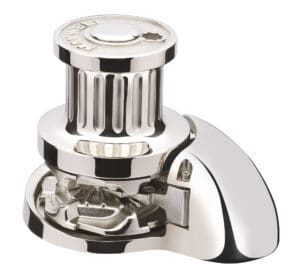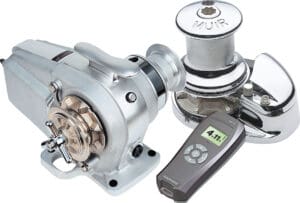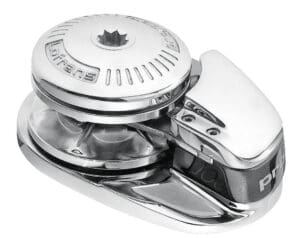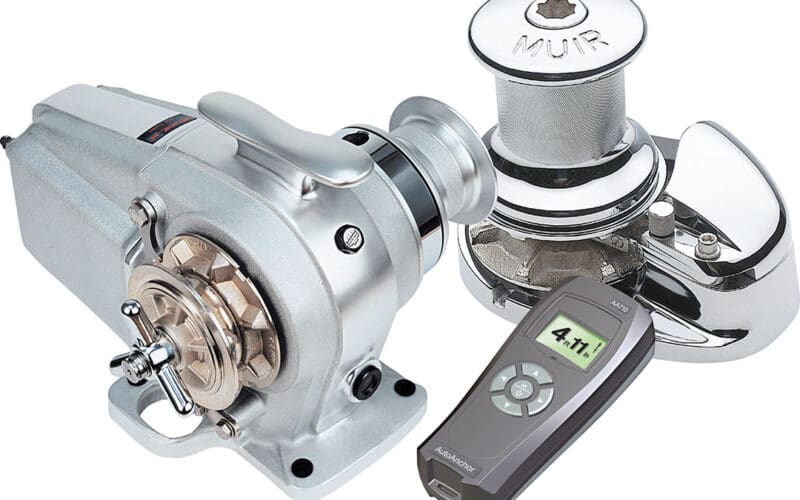At the dinghy dock the other day, a cruiser, clearly frustrated, was grumbling, “I bought all of this chain and I just can’t get it to work in my windlass!” Unfortunately, we hear laments like this all too frequently, but it doesn’t have to be. For voyagers looking to get the right chain the first time for their power voyaging boats it’s helpful to understand chain manufacturing standards, grades, sizing, and when necessary, its fitment to a gypsy.

First off, if a windlass is not involved then just about any chain can be used as long as it has the requisite work load limit (WLL). Not so if a gypsy (aka: wildcat or chain wheel) is involved.
A gypsy is designed to fit a chain of specific dimensions, but chain dimensions are dictated by which manufacturing standard is followed. Pick the wrong manufacturing standard and chances are the chain won’t work in a gypsy manufactured to a different standard.
Manufacturing standards
In North America, the two manufacturing standards for chain are the ISO Standard (International Standards Organization) synonymous with Peerless/ACCO chain, and NACM Standard (National Association of Chain Manufacturers) often referred to as general purpose chain.
Familiarity with these two standards is important, because: 1) The links of ISO chain are shorter and wider than those of the same size NACM chain. 2) Gypsies are more often designed for ISO chain, with fewer designed for NACM chain. 3) Chain made to the ISO standard usually has been doubled-dipped — in other words it has been left in the molten zinc for a longer period of time, providing a thicker coating of galvanizing, thus a longer service life.
There are a few ways to determine which standard applies to a particular chain: ask the sales person, but often they won’t have this particular knowledge; check the shipping container as often the manufacturing standard is stamped on it; or, call the manufacturer and inquire.
Another way to determine which standard a chain was manufactured to is to measure the inside width and length of a few links to the hundredth of an inch and then compare these measurements to the dimensions provided in these two standards.
When comparing these measurements keep in mind that there is a plus or minus allowance which is also noted in the standards. Manufacturers also have this information either in their literature or it can be obtained from the company’s engineer.

Grade
Once you establish which standard applies — ISO or NACM — the next step is to determine which grade of chain to use: Grade 30 (Proof Coil or BBB) or Grade 43 (High Test). (In 2005, the designation of Grade 40 was discontinued, and High Test chain in both of these standards is now referred to as Grade 43.)
In the same sizes, there is not much difference in weight between G30 chain and G43 chain, but G30 chain will have a lower WLL. On the other hand, if you compare G30 chain to G43 chain with equivalent WLLs, you will find significant weight and cost savings with G43 chain.
Mandated in both standards are raised letters/numbers (hallmark) on the links of the chain to indicate its grade. Though some manufacturers use a proprietary mark, the generic markings for Grade 30 chain are: G3, G30, PC, BBB, or 3B. For Grade 43 chain they are: G4, G43, HT, or H4.
There is also a Grade 70 chain, usually stamped G7, which is even lighter and stronger than G43. While G30 and G43 chain do not lose strength when galvanized, G70 loses 20 percent of its strength, posing a potential danger to those unaware of the chain’s now lower WLL.
Once galvanized, this loss of strength can be recovered if the chain is sent back to be heat-treated a second time. But few companies do so unless requested; plus, it adds to the cost. To be safe, unless verified that a galvanized chain stamped G7 has been twice heat-treated, you must assume that its strength is 20 percent less than its published rating.
The Peerless/ACCO Company solves this problem of lost strength another way; for G70 chain that will be galvanized, they rename it G60 and stamp it G6.
Every great once in a while you may run across the hallmark SL. This is a retired hallmark that was used in the past by ACCO/Peerless to designate short link chain, now replaced by the designation Triple B (aka: BBB or 3B).
If there is no hallmark on the chain’s links, the chain’s quality, dimensions, or strength is up for question and its use in ground tackle is best avoided.

Another important reason for knowing a chain’s grade has to do with shackles. To be assured that a shackle will fit and match the WLL of the chain, choose a shackle manufactured to Fed. Spec. RR-C-271, often referred to simply as 271.
Although 271 shackles are often also referred to as “domestic” shackles, this does not necessarily mean that all shackles referred to as domestic conform to the dimensions that will fit High Test chain. If a shackle is referred to as domestic it is best to verify that they also conform to 271.
For Grade 30 chain, either Proof Coil or BBB, regular-strength (carbon) shackles, which are those found in hardware stores, home improvement centers, and chandleries, will work, if manufactured to 271.
What causes folks headaches is trying to mate shackles to G4 (High Test) chain, though the remedy is simple. For shackles to fit and match WLLs of High Test chain, high-strength (alloy) shackles manufactured to 271 must be used. Alloy shackles might be available through industrial supply shops, maybe a chandlery, but they definitely can be found on the internet.
Stainless steel chain
There is also stainless steel chain which is manufactured under the NACM stainless steel specifications. This stainless steel chain is stronger than Grade 30 chain, but not as strong as Grade 43.
Though it is the NACM stainless steel standards that have the specifications for strength and dimensions, some companies also manufacture stainless steel chain that matches the dimensions of Proof Coil, BBB, and High Test in both the ISO and NACM standards, though the strength of the chain remains as noted above. This is done in order that those who wish to use stainless steel chain can find a gypsy designed for these dimensions.

Unlike carbon steel chain which provides advanced warning of impending doom in the form of rust stainless steel chain, even 316L, has idiosyncrasies that can allow it to fail, often without warning:
• It can, especially when used in saltwater, develop small cracks, particularly around the welds, some essentially invisible.
• It is susceptible to oxygen deprivation when used in oxygen-poor water, such as water that is polluted or when buried in the seabed, allowing pitting and crevice corrosion to develop.
• It has poor elongation properties, giving little warning that the chain has approached its point of failure.
To minimize failures, stainless steel chain should be closely inspected, often yearly, and maybe more frequently if the chain is used often or has been immersed for long periods of time. Any stainless steel chain with discoloration, pitting, crevice corrosion or cracking should be removed from service until further evaluated.
Other standards
The standard for metric chain is Din 766. This standard specifies two strengths for carbon steel chain ¾ G30 and G40. Din 766 also has a G60 spec for stainless steel chain.
There is also an Australian Standard, stamped with an L, for regular strength chain, or M, for High Test chain.
Sizing
Once the appropriate manufacturing standard and grade of chain has been decided, the final decision would be that of the chain’s size. This step is always based on choosing a size of chain that has a WLL that equals or exceeds the highest load to which the chain can be subjected.
There are several tables or formulas available that can be used to calculate the load that can be placed on ground tackle, but be forewarned, not all of these tables include important influences such as wind gusts, surge, degree of protection from seas, nor a safety factor.
A copy of the load table that we prefer has been reproduced in the side bar or it can be viewed at trawlertrainingabc.com.
• This table includes loads contributed by waves, seas, gusts, plus a safety factor.
• The loads noted in this table loads apply when the protection from seas is moderate. If the protection would be considered poor, these loads should be increased by 50 percent; if protection can be considered good, these loads can be decreased up to 50 percent.
• The loads in this table are for traditional sailboats. For powerboats, trawlers, multihulls, houseboats or contemporary sailboats with more freeboard, beam, or top-hamper than that of traditional sailboats, increase these loads by 50 percent.
• If the boat is not free to oscillate, e.g., anchored fore and aft, should the wind come on the boat’s beam, the loads in this table should be increased by 30 percent.
Gypsies
It’s only after you’ve established which manufacturing standard, grade, and size of chain to use do you then turn your attention, if one will be used, to the gypsy. You should not match a chain to a gypsy, but instead match the gypsy to a chain that has the appropriate WLL.
With an existing windlass, if there is no indication stamped on the inner or outer aspect of the gypsy, or if the stamping is not clear as to what chain to use, call the manufacturer and inquire.
Be prepared to discover that some customer service reps may not be aware that there are various standards to which chain can be manufactured. If uncertainty exists, see if the manufacturer’s engineer can be of help.
You can also check the Anchor Windlass Chain Fitment Chart on-
line to see if your windlass is listed.
Sizing a gypsy
If you’re still not sure what chain will fit your gypsy, you can: 1) send the gypsy, preferably insured, to a chain supplier to identify the correct chain; 2) take the gypsy to a local chain supplier and there trial fit various chains; or, 3) obtain a few feet of possible choices from a chain supplier and trial fit them yourself.
It’s not wise to choose chain based only on its ability to fit an existing gypsy; instead, always pick a gypsy that can accommodate chain that has the necessary WLL.
If it is necessary to change to a different size of chain call the manufacturer of the windlass and ascertain whether they have a gypsy that will match the new chain. If a gypsy is not available for the desired chain, you’ve no choice but to replace the windlass.
If a chain is slipping, instead of assuming that the gypsy is worn, first investigate whether the gypsy was made to one standard and the chain to another, or maybe the wrong size chain is being used.
Finally, when it comes to obtaining a significant amount of chain, to get more chain for the same price as would be a lesser amount, ask the supplier where the price break occurs. n
Rudy and Jill Sechez are seemingly always on the go, living aboard and cruising since 1997. They are the authors of Anchoring-A Ground Tackler’s Apprentice, available as hard copy, App or e-book. Contact them at rudysechez@gmail.com; visit their website at, trawlertrainingabc.com.

